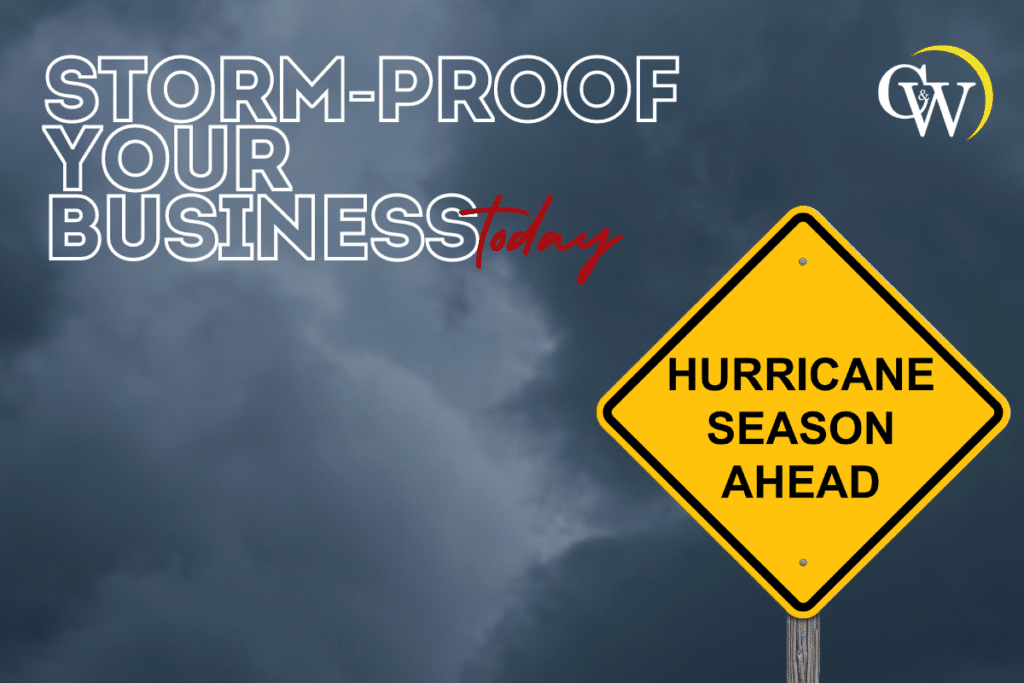June 1st marks the beginning of hurricane season, a time when businesses must be particularly vigilant and prepared for potential disruptions. The importance of readiness cannot be overstated, especially when it comes to safeguarding your business and technology. Hurricanes can lead to power outages, flooding, and significant infrastructure damage, all of which can severely impact operations.
Proactive preparedness strategies are essential to mitigate these risks and ensure that your business remains resilient in the face of such natural disasters. In this guide, we will explore advanced hurricane preparedness techniques for technology and operations to help you storm-proof your business.
Understanding the Risks
Before delving into specific strategies, it is crucial to first understand the risks that hurricanes pose to businesses. Hurricanes can cause a wide range of damages, from power outages and infrastructure damage to data loss and supply chain disruptions.
Power outages can occur due to high winds knocking down power lines or flooding causing damage to electrical systems. This can have a severe impact on businesses, particularly those that rely heavily on technology and require constant access to electricity.
Infrastructure damage is another common issue during hurricanes, with strong winds and heavy rains often causing extensive destruction to buildings, roads, and other critical infrastructure. Disruptions to supply chains can also occur due to damaged transportation systems and disrupted communication networks.
Hurricanes can also lead to data loss, which can be devastating for businesses that rely on technology for their operations. This can happen due to power outages damaging servers or flooding destroying equipment, resulting in the loss of important data and information.
Developing a Hurricane Preparedness Plan
In light of these significant risks, it is imperative for businesses to develop a comprehensive hurricane preparedness plan. To help you get started, we have outlined five crucial tips that will assist in safeguarding your operations and technology. By implementing these recommendations, you can enhance your business’s resilience and ensure continuity even in the face of a hurricane.
Backup Data Regularly
Ensure that all critical data is backed up offsite or to a cloud-based service. This reduces the risk of data loss due to power outages or physical damage to on-premises equipment.
Unplug Non-Essential Devices
Before the storm hits, unplug non-essential electronic devices to prevent damage from electrical surges. Use surge protectors for essential equipment that must remain plugged in.
Invest in a UPS (Uninterruptible Power Supply)
A UPS can provide backup power to keep essential systems running during short-term outages and help you shut down equipment properly to avoid data corruption.
Protect Hardware with Waterproof Containers
Place critical hardware such as servers and networking equipment in waterproof containers or elevate them off the ground to protect against flooding.
Establish Remote Access
Ensure that employees have remote access to necessary systems and data. This allows business operations to continue even if the physical office is affected by the hurricane.
How C&W Technologies Can Help
C&W Technologies stands ready to assist your business in navigating and preparing for the challenges of hurricane season. With decades of experience in IT solutions and disaster recovery, we offer a range of services designed to enhance your business’s resilience and ensure continuity.
From cloud-based backups to remote access solutions, our company can help you implement advanced hurricane preparedness measures for your technology and operations. Contact us today to learn more about how we can help stormproof your business. So, whether you are a small business owner or part of a large organization, it is crucial to take proactive steps towards hurricane preparedness for the safety and continuity of your business operations.
Don’t wait until a storm is on the horizon, start implementing these strategies now to ensure that your business can weather any storm. Stay safe and stay prepared! So whether you are a small business owner or part of a large organization, it is crucial to take proactive steps towards hurricane preparedness for the safety and continuity of your business operations.
To further assist you in storm-proofing your business, we have created a comprehensive hurricane preparedness video available on our YouTube channel. In this video, our experts delve deeper into each preparedness tip and provide actionable insights to ensure your business remains resilient during hurricane season.
Watch our Hurricane Preparedness Video on YouTube now!
Stay informed, stay prepared, and ensure the safety and continuity of your business operations by integrating these essential strategies. Let’s work together to build hurricane resilience and minimize the impact of natural disasters on businesses. Remember, preparation is key when it comes to surviving the storm.
By taking these proactive steps, you are already on the path to safeguarding your business from the devastating effects of hurricanes. However, you don’t have to do it alone. C&W Technologies is here to provide expert guidance and tailored solutions to enhance your hurricane preparedness.
Contact us today to learn how our comprehensive IT solutions can fortify your business against any storm. Let’s work together to ensure your operations remain uninterrupted and secure.
Frequently Asked Questions (FAQs)
Q: What is disaster management, and why is it important for businesses?
A: Disaster management involves preparing for, responding to, and recovering from natural or man-made disasters. For businesses, it is crucial as it helps minimize the impact of such disasters, ensuring safety, and operational continuity, and reducing financial losses.
Q: What is disaster recovery planning, and how can it benefit my business?
A: A Disaster recovery plan is creating a set of policies and procedures to enable the recovery or continuation of vital technology infrastructure and systems following a natural or human-induced disaster. For businesses, it significantly benefits by ensuring that critical business functions can operate despite interruptions, minimizing data loss, reducing downtime, and ultimately protecting the company’s financial health and reputation.
Q: What is a Recovery Point Objective (RPO), and why is it significant for disaster recovery?
A: Recovery Point Objective (RPO) refers to the maximum acceptable amount of data loss measured in time. It defines the point to which data must be recovered to resume operations after a disaster.
Q: What are the key benefits of using a cloud disaster recovery plan for my business?
A: Key benefits include scalability, flexibility, and cost-efficiency. Cloud disaster recovery plans offer scalable storage options that can adapt to your business needs without the requirement for physical hardware. They also enable faster recovery times, ensuring business continuity with minimal downtime.
Q: What is a data center, and why is it important for modern businesses?
A: A data center is a dedicated space where businesses house their critical IT systems and data. It includes servers, storage systems, networking equipment, and other infrastructure essential for processing, storing, and managing large amounts of data. Data centers are crucial for modern businesses as they support key operations, ensure data availability, and provide the robustness needed to handle enterprise workloads efficiently.
Q: How can a data center improve my business’s operational efficiency?
A: Data centers improve operational efficiency by centralizing your IT infrastructure, allowing for better resource management, scalability, and security. They provide an environment optimized for high performance, ensuring that applications run smoothly and reliably. Additionally, they offer advanced cooling and power solutions, reducing the risk of system failures and downtime. Centralization also simplifies IT management and maintenance, freeing up resources to focus on strategic business initiatives.
Q: What factors should I consider when selecting a data center for my business?
A: Key factors to consider include location, reliability, scalability, security features, and compliance with industry standards. The data center should be in a location with minimal risk of natural disasters and in proximity to your business operations for lower latency.
Q: How can ERM (Enterprise Resource Management) software improve my business’s operations?
A: ERM software can significantly enhance business operations by providing a unified platform for managing all aspects of the business. It offers real-time insights into resource utilization, helps automate routine tasks, and improves decision-making through data analytics. This leads to better coordination between departments, reduced operational costs, and increased overall efficiency.
Q: What are critical systems, and why are they essential for businesses?
A: Critical systems refer to the essential technology infrastructure and applications that are vital for the core operations of a business. These systems are crucial because their failure or downtime can significantly disrupt business processes, resulting in operational delays, financial losses, and damage to the company’s reputation. Ensuring these systems’ reliability and availability is imperative for maintaining business continuity.
Q: What is an IT disaster recovery plan and why is it essential for businesses?
A:An IT disaster recovery plan is a documented set of procedures to help businesses recover and protect their IT systems during a disaster. It is essential because it ensures that critical services are quickly restored, minimizing downtime, preventing data loss, and maintaining business continuity.
Q: What are technology recovery strategies, and why do they matter for businesses?
A: Technology recovery strategies are comprehensive plans and procedures designed to restore IT systems and data following a disruption or disaster. They are crucial for businesses because they ensure that critical technology infrastructure can be rapidly recovered, minimizing downtime and data loss, and maintaining business continuity. Effective technology recovery strategies help safeguard against financial losses and protect the company’s reputation.
Q: How can technology aid in natural disaster recovery?
A: Technology can aid in natural disaster recovery by providing tools for efficient communication, data backup and recovery solutions, and real-time monitoring systems. Cloud services can ensure that data and applications remain accessible even if physical locations are compromised.
Q: What immediate steps should I take when a disaster occurs?
A: When a disaster occurs, the first priority should be ensuring the safety of all personnel. Follow your emergency response plan, which might include evacuating the premises if needed. Once individuals are safe, activate your disaster recovery plan immediately. This involves assessing the extent of the damage, communicating with your disaster recovery team, and initiating data backup procedures. Engaging with your IT department early on will help to mitigate further damage and enable a faster recovery process.
Q: What are disaster recovery sites, and why is it important?
A: A disaster recovery site is a physical location or facility separate from a primary data center, where critical IT infrastructure and operations can be relocated in the event of a disaster. It is important because it ensures that business operations can continue with minimal disruption, maintaining availability and performance of essential systems and data.
Q: Why is it important to have a disaster recovery plan template?
A: A disaster recovery plan template is important because it provides a structured and organized framework for businesses to follow in the event of a disaster. It helps ensure that key steps are not missed, allows for easy customization based on the specific needs of the business, and aids in efficiently coordinating efforts among team members.
Q: What is the disaster recovery process and how does it benefit my business?
A: The disaster recovery process is a series of structured steps and procedures designed to restore a company’s critical IT systems and data following a disruption. This process benefits your business by minimizing downtime, preventing data loss, and ensuring that essential operations can resume swiftly.
It typically includes data backup, system recovery, and communication protocols, all aimed at maintaining business continuity and protecting the company’s resources. By having a well-defined disaster recovery process, businesses can better prepare for unforeseen events, mitigate risks, and secure their position in the market.



